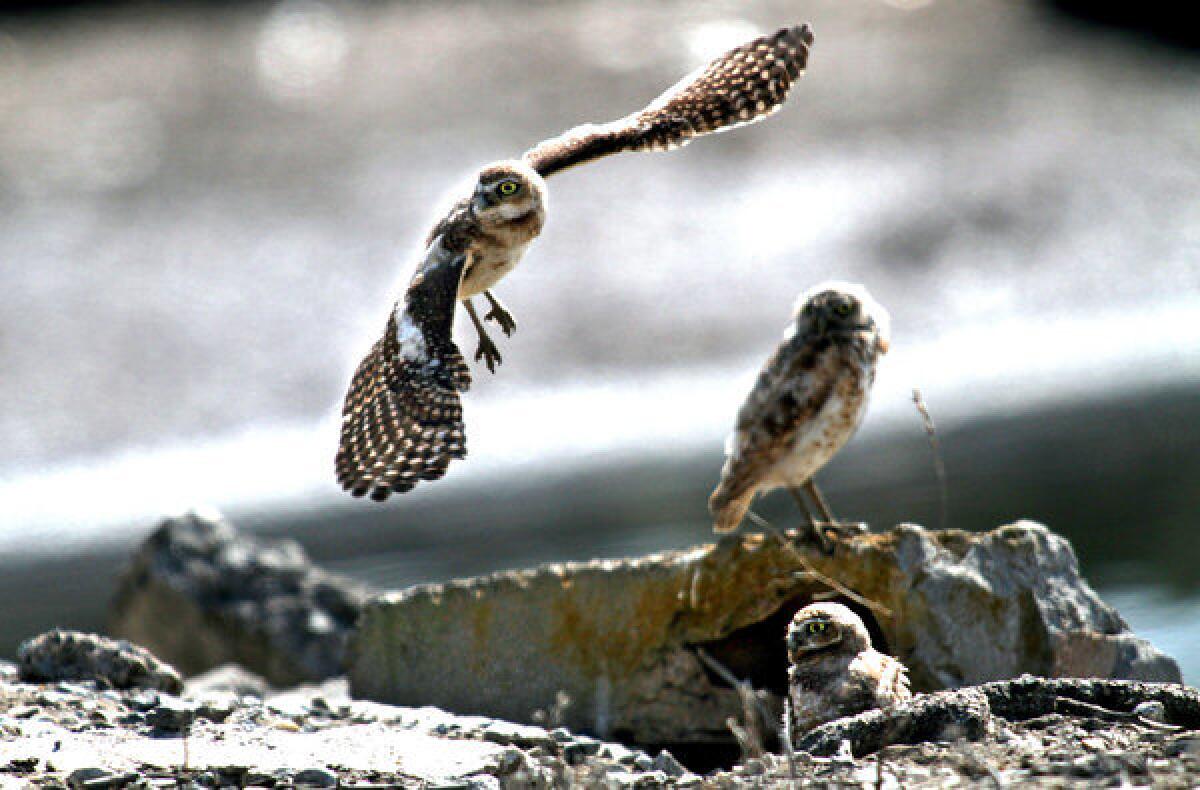Navy steps up efforts to protect burrowing owls at weapons base

Five juvenile burrowing owls flapped across a salt marsh at the Seal Beach Naval Weapons Station on a recent weekday, matching the loops and curves of dragonflies and moths before snatching their prey midair.
Soon, the owls will be feasting on larger prey, including lizards, rodents and birds. That could present a touchy problem for the base’s 1,000-acre wildlife refuge, which is also home to a breeding colony of federally endangered least terns.
There are four breeding pairs of burrowing owls left along the Southern California coast between Santa Barbara and Encinitas, and all of them nest at the Orange County base.
The terns are about a half-mile away from the owls’ nest in a hole once inhabited by ground squirrels. Burrowing owls, which are listed as a “species of special concern” by the state Department of Fish and Wildlife, tend to feed within a mile of their nest. The owl’s designation provides modest protections assigned to animals deemed at risk but not threatened or endangered.
Peering through a spotting scope, Peter Bloom, a biologist who has been monitoring the base’s avian life for 35 years, said: “It would be possible for these little guys to raid that colony of least terns. If that were to happen, the Navy would have to deal with the problem of a modestly protected species eating a federally endangered species.”
The situation underlines the difficulty facing wildlife biologists in ensuring the survival of borderline species clinging to existence in Southern California’s patchwork of isolated habitats surrounded by urban development.
“This base is the ultimate example of fragmented habitat,” Bloom said. “The next nearest burrowing owl nests along the coast are 70 miles to the south and 90 miles to the northeast. These birds can’t find each other anymore.”
As he spoke, the wide-eyed juvenile owls with long legs hunkered down beside the entrance to their burrow and stared back at him. Nearby, an adult owl gave an alarm that resembled the sound of a rattlesnake.
The fledgling owls were discovered two weeks ago by Navy biologist Bob Schallmann, who hopes they pave the way for the bird that scientists know as Athene cunicularia to reestablish residency in a place where dozens of breeding pairs were recorded in the late 1960s, biologists said.
The Navy has stepped up efforts to protect burrowing owls within its premier weapons loading, storage and maintenance installation, which includes the wildlife refuge — one of the least frequented, most restricted patches of wilderness in the United States.
“If the burrowing owl were to become an endangered species, the new protections that would have to be implemented might hamper the operations conducted here,” Schallmann said. “So we’re restricting traffic and other disturbances in the vicinity of their nests, and encouraging growth of native plants and grasses that are magnets for insects they prey on.”
Burrowing owls were among the state’s most common birds in the late 1800s and early 1900s. Their numbers have been dropping steadily since the 1940s because of habitat loss through urban development, elimination of rodents they feed on, pesticides, predation by domestic animals, vehicle strikes, collisions with wind turbines and shooting, according to the Center for Biological Diversity.
Now, an alarming decline in the numbers of breeding burrowing owls in Imperial County — an area with the largest population of the owls in the state — has prompted calls for an immediate inquiry by state wildlife authorities.
Surveys conducted on behalf of the Imperial Irrigation District show the Imperial County owl population has declined from an estimated 5,600 pairs in the early 1990s to 4,879 pairs in 2007, and to 3,557 pairs in 2008.
It is unknown what is causing the Imperial County owl decline, but loss of suitable foraging areas from fallowing of agricultural fields due to water transfers and ground-squirrel eradication programs may play a role, according to biologists with the Center for Biological Diversity.
In 2003, a coalition of environmental groups led by the center filed a petition under the Endangered Species Act to protect the owl.
“The decimation of breeding owl populations in Orange and San Diego counties is indicative of the fate of the species in urbanizing areas of the state,” the 118-page petition argued. “Even as late as 1975, burrowing owls were described as ‘abundant’ and ‘bordering on ubiquitous’ in suitable habitat in Orange County and were considered a ‘regular component’ of the coastal environment. By 2001, only 9 or less breeding pairs remained in the entirety of Orange and San Diego Counties.”
The California Fish and Game Commission rejected the petition, in part, because it believed the bird continued to thrive in the Imperial Valley and along the lower Colorado River. “Although burrowing owls have clearly declined in some parts of their range in California,” the commission responded in a 57-page report, “sufficient data is lacking in other parts of the state to indicate a decline, and healthy populations of Western burrowing owls exist in others areas of the state. It appears that there has been a shift in population density, such that the Imperial Valley and Palo Verde Valley support populations and have reached densities that were not likely present historically.
“In California, burrowing owls have shown incredible tolerance for human encroachment and degradation of native habitats,” the commission concluded. “In urban areas, they are often found nesting within landfills, golf courses, airports, and vacant lots within highly developed areas.”
Jeff Miller, a conservation advocate with the Center for Biological Diversity, disagrees. His group plans to submit another petition to strengthen protections for the owl and its habitat.
“In fact, the future is pretty grim for burrowing owls,” Miller said. “Without suitable habitat and active management, California could lose them.”
More to Read
Sign up for Essential California
The most important California stories and recommendations in your inbox every morning.
You may occasionally receive promotional content from the Los Angeles Times.










